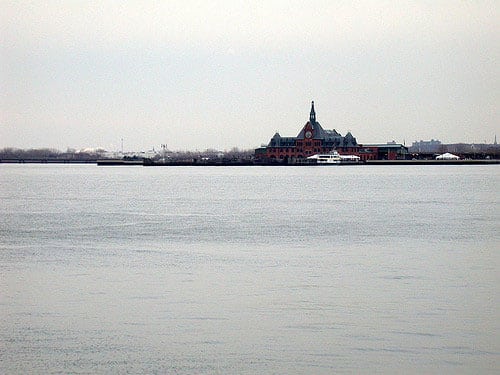
September 27, 2018; Hyperallergic and New York Times
A short distance from the mainland in New York Harbor sits Governors Island, 172 acres that have seen a tumultuous and storied history. It is a unique part of New York City that has no residential buildings at all, despite beautiful landscaping and a stunning view of the city. Instead, it has served for decades as a cultural and recreational haven, where many arts groups have space to work and city dwellers can come enjoy a quieter park setting.
But in the urban rush to claim unique cultural spaces and “maximize” their use, the tranquility of the island has been imperiled. Now, a group of 14 artists and cultural organizations are trying to make themselves heard amid the din of rezoning and development planned for Governors Island.
Deputy Mayor Alicia Glen and Michael Samuelian, president of the Trust for Governors Island, envision a mixed-use neighborhood where New Yorkers will come to work and play. Glen wants to build a hotel, a “really cool” convention center, and maybe even a university research center. “We want more people to enjoy it, and we want all these uses to work together,” she told New York Times’ Helene Stapinski. “Artists and poets are usually not so great about what it costs to run a ferry and get freight on and off the island and keep the lights on.”
Artists and poets have only been using the island since the 2000s. The Lower Manhattan Cultural Council opened a retreat-style artist residency with public exhibitions in 2010. Before that, it was used by the military, dating from the Revolutionary War. It originally belonged to the Lenape people, who lived in and around what is now New York City.
Sign up for our free newsletters
Subscribe to NPQ's newsletters to have our top stories delivered directly to your inbox.
By signing up, you agree to our privacy policy and terms of use, and to receive messages from NPQ and our partners.
Developers have been wanting to make Governors Island a playground for the rich since 1995, when the Coast Guard left. According to Stapinski, “A soccer stadium, a free-trade zone, a red-light district, a Sponge-Bob-themed hotel, a golf course, a prison and an amusement park have all been floated.” Instead, because it is zoned for housing but no residential buildings are permitted, and because it contains a national monument, it has so far resisted the frenzy of development that overtook the rest of New York. But the rezoning statement from Mayor de Blasio’s office reads, “This effort has the potential to unlock up to 4.5 million square feet of commercial, academic, cultural and institutional development that would complement and financially sustain the Island’s popular park, public programming, and cultural amenities.”
The artists fear that the rezoning will push them out and make the island too expensive to use. Lori Nelson, who’s worked on the island for years, says the artists built their community “without basic amenities, like running water.” They’re not opposed to the rezoning, nor are they protesting, but they have some serious questions, including:
- “What is the cultural strategy for Governors Island that defines its mission in alignment with the 2003 deed, preserving the island as a place for the people of New York to enjoy a diversity of arts experiences?”
- “Will multiple year commitments be offered from the Island to its accepted and long-standing arts partners?”
- “Will there be a more diverse panel appointed to review arts and cultural proposals, including members of the existing cultural community?”
- “What is the Percent for the Arts model that the island has or will have in place to support community-based arts organizations? Will a fund be established to provide for smaller cultural organizations to continue operating on the island?”
- “In connection with the Second Supplemental Generic Environmental Impact Statement (SSGEIS), how will you define the ‘relevant community’ in order to determine the impact on such community?”
It is an unfortunately common phenomenon that artists are pushed out of neighborhoods by wealthy (often white) renters and buyers looking to participate in the cultural setting the artists helped create. The Ghost Ship fire in 2016 was just one example of the extremes to which artists are often pushed by this trend. Governors Island is a bit different, since no one lives there, but already one art fair, called Figment, has relocated to Roosevelt Island.
“It has gotten harder and harder to work there given the population, given the desire to increase the season, the increase to seven days a week,” said Figment founder David Koren. “More and more process has been added in terms of permits and costs.”
Deputy Mayor Glen is not concerned about the artists’ petition. In a blithe democracy-dismissing moment, she added, “It’s New York…everybody freaks out about everything.”—Erin Rubin













